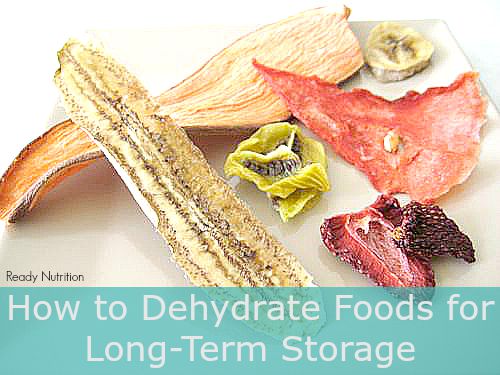 [1]
[1]For centuries, dehydrating food has been seen as a survival necessity. Many believe this preservation method is the safest, most affordable and best way to preserve flavors of foods. The dehydration process removes moisture from the food so that bacteria, yeast and mold cannot grow. The added benefit is the dehydration process minimally affects the nutritional content of food. In fact, when using an in-home dehydration unit, 3-5% of the nutritional content is lost compared to the canning method which losses 60-80% nutritional content. Additionally, important vitamins and nutrition such as: vitamin A and C, carbohydrates, fiber, potassium, magnesium, selenium and sodium are not altered or lost in the drying process. Therefore, the end result is nutrient packed food that can be stored long-term.
How Can a Person Use a Dehydrator
In the book, The Prepper’s Cookbook [2], I outline the multiple ways that one can use a dehydrator. They can dry vegetables, fruits, make jerky, make fruit or vegetable leather, dry herbs, make spices, dry soup mixes, noodles, and even make crafts. When I first began dehydrating foods, I purchased a modest dehydrator [3]. Then, I realized how much I loved it and got a higher end model [4].
Dehydrating vegetables and fruits to use for long-term storage is a great way of including needed nutrition into diets with minimal investment. When dehydrating food, one should use fresh produce or meat. Typically, when overly ripe fruits and vegetables are dehydrated, the texture is not as crisp. For example, if one were to dehydrate over ripe bananas, the end result would be a chewy banana chip as opposed to a crispy banana chip. If a person were to use the ripe fruits or vegetables, they could puree the produce and make fruit or vegetable leather to use later.
How Long Does Dehydrated Food Last
In most cases, dehydrated food can be stored for up to a year. Once dehydrated, the food does not take up a lot of space, and can be stored in a more organized fashion.
- Fruits and vegetables can last for up to 1 year, if properly stored.
- Dried meats should be consumed within 2-3 months. However, it is suggested that if dried meats have not been consumed after 1 month, they should be stored in the refrigerator to prolong the freshness.
- Herbs can last for years.
- Noodles should be eaten within 1 year in order to enjoy the freshness.
If a person wanted to rehydrate the food to use in cooking, add boiling water and cover with a lid for 20-30 minutes to expedite the process. Note: it is recommended to add salt after the rehydration process [5] has been completed.
Storing Dry Foods
Once food has been dehydrated, it should be stored in an area not exposed to a lot of light, such as a pantry. It is recommended that any food that contains vitamin A not be exposed to light. According to James Talmage Stevens’ book, Making the Best of Basics [6], Stevens recommends these general storage suggestions:
- Freezer zip-lock bags are excellent for packaging dried foods. Force excess air from bags as they are sealed.
- Procure heavy-duty, food-grade, storage-quality, sealable plastic bags [7] from local commercial packaging wholesalers.
- Store dried food products in a cool, dry location out of direct sunlight. Use a craft paper [8] inside larger plastic bags to shield dried foods from sunlight. Paper used outside the plastic bags provides a nesting place for bugs or spiders.
- Store only one kind of food in each individual package to avoid mixing flavors and possible cross-contamination should molds or spoilage occur.
- Another method for storing dried products is to place dried food in a food-quality, plastic bag, then put it in an airtight glass or metal container.
- Discard moldy food. Don’t take chances on botulism or a debilitating sickness over a few pennies or dollars. Don’t feed mold foods to pets, either!
- The problem of a few bugs in dried foods may be solved by spreading the infested dried food on a cookie pan, placing in tn a 300 degree oven for 25-30 minutes. Bugs and eggs die, and the food is edible again.
In planning for a long term disaster, people are always trying to find foods they can look forward to that will give them optimum nutrition. Having the necessary vitamins and nutrition will give a person mental clarity, and strength to carry on during a disaster. After all, surviving and being healthy is what matters.
